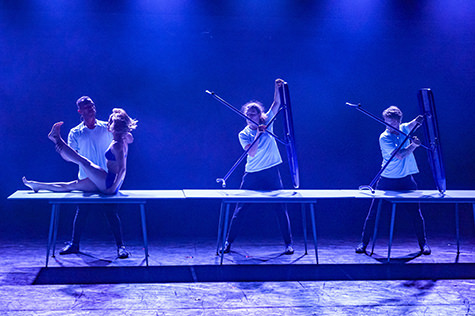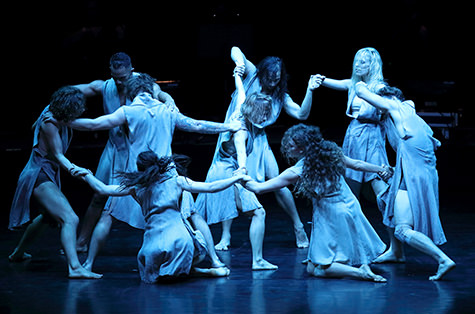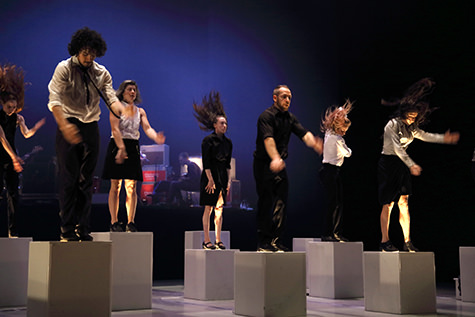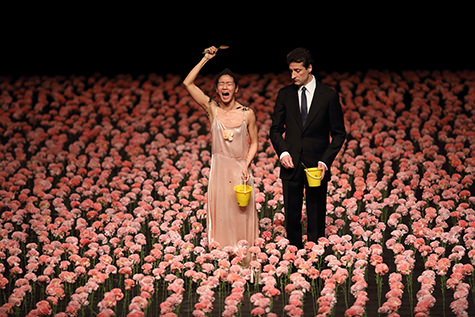Dances of protest
Ben Brooker: ADT, Holy Body Tattoo, Pina Bausch

Habitus, Australian Dance Theatre
photo Chris Herzfeld, Camlight Productions
Habitus, Australian Dance Theatre
Australian Dance Theatre, Habitus & The Beginning of Nature
Australian Dance Theatre Artistic Director Garry Stewart has stated that the exploration of humanity’s relationship to the natural world will form the basis of a number of works by the company over the next few years. The first fruits of this focus, Habitus and The Beginning of Nature, received their premieres at this year’s Adelaide Festival and WOMADelaide respectively. They could hardly have come at a more apposite moment, recent reports indicating that civilisation is heading towards disastrous, human-induced climate change even more rapidly than previously thought, with 2016 set to break global temperature records for the third successive year.
In Habitus, our conflicted relationship to the excesses of the materialist economy is highlighted by Stewart and Larissa McGowan’s richly humorous choreography in which the movement of bodies through space is shaped by a cornucopia of consumer goods: books, sofas, ironing boards and the like. These familiar items are rendered comical, uncanny like the decontextualised objects of surrealist art. They are also malignant: a key moment sees one of the performers crushed beneath a sofa, fighting for life. They draw out, both by their suffocating corporeality and sheer proximity, extreme physical responses from the dancers, such as heavy, urgent breathing and violent retching. “The sad thing is,” Thomas Fonua tells us in one of the work’s spoken word sections, “all this shit—chairs, tables, sofas, whatever—is ultimately going to end up as landfill.”
But the work also foregrounds our inseparability from “all this shit.” Echoing economist Victor Lebow’s claim that “our enormously productive economy demands that we make consumption our way of life,” the dancers’ bodies become integrated with, and extended by, the objects of our consumer desires, stacks of books, for example, becoming monstrous stilts. Performers Zoe Dunwoodie and Michael Ramsay, meanwhile, swap “sofa memories” of disarming, sometimes unsettling intimacy (“this is where I lie when I listen to Miles Davis/ this is where I cried when I learned my father had died”). Brendan Woithe’s sound design is correspondingly split between ironic rhapsodising (the deployment, for instance, of baroque music during a Regency-like passage in which the dancers lovingly balance books on their heads) and banal metronomics (the incessant ticking of clocks and dripping of water).
Stewart notes in the program that “an undercurrent to our consumerist excesses is the thought that some day ‘all of this’ will be reclaimed by nature.” The work’s finale, bringing to mind King Lear’s “blasted heath,” sees an apocalyptic storm reconfigure the stage’s detritus as a kind of midden, the accumulated, un-biodegradable domestic waste of multiple generations stacked high. Human figures—worshippers, scavengers, ghosts?—circle it cautiously. “Where are we?” one of them asks, “what is this place?” It is, I suppose, a kind of monument to human folly, a 21st century equivalent of the “martyred village” of Oradour-sur-Glane that Charles de Gaulle ordered be conserved as a permanent reminder of Nazi barbarism. “As I exhale my last breath,” Fonua says in a final monologue, “none of this will disintegrate with me, but will persist and persist and persist, stretching for an eternity well beyond the traces of this brief existence.”

The Beginning of Nature, Australian Dance Theatre
photo Tony Lewis
The Beginning of Nature, Australian Dance Theatre
ADT’s The Beginning of Nature, premiered at WOMADelaide, might be Habitus’ ‘origins’ story or, perhaps, a more fleshed-out account of its vision of a post-apocalyptic world repossessed by nature. Arguably it is both, the work seeing Garry Stewart’s familiar choreographic vocabulary supplemented with rhythms and shapes drawn from the endlessly returning cycles of the biosphere: “day and night, the seasons, tidal patterns, migration, hibernation, sleep and waking, weather patterns, the binary of growth and decay, and the various systems of the body” [program]. Its object world is populated by the natural rather than the anthropogenic: rocks and trees transported through the space with the assiduousness of ritual and revered as in pre-Christian religion. The work is underpinned by images of birth, death and rebirth, situating divinity in nature and suggesting the sacred feminine as the originating principle of all life.
Brendan Woithe’s score (read an interview with the composer), an immense, shuddering wall of tonal sound generated by the composer in real time by stretching and looping the live orchestrations of the Zephyr Quartet, reinforces Stewart’s interest in feedback systems. In one part it resets every few seconds with a deep growl like a giant turntable starting up with the needle already in place. Two vocalists, Shauntai Batzke and Vonda Last, sing in the recently revived language of the Kaurna People, the traditional owners of the Adelaide Plains (Tarndanya). The simple vocal lines and bell-like voices recall the ‘holy minimalism’ of 20th century composers Henryk Górecki and John Tavener, even if the decision to incorporate Kaurna language into Woithe’s score remained, for me, confounding.
Like Habitus, The Beginning of Nature is an unsubtle, though less didactic, work that questions humanity’s place in the natural order. To my mind, Habitus is the more successful of the two, its nuanced twinning of humour with accessible dramaturgy the more adroit vehicle for exploring our increasingly vexed relationship to the ecological systems that simultaneously sustain and are most threatened by us. I wondered if, conversely, The Beginning of Nature’s retreat into Rousseauian longing for an imagined golden age didn’t in fact signal a kind of defeatism, a (gentle) refusal to confront the global environmental crisis on anything but the most fabulist of terms.

monumental, Holy Body Tattoo
photo Tony Lewis
monumental, Holy Body Tattoo
The Holy Body Tattoo, monumental
Staying with Rousseau, it might be said that monumental, performed by Vancouver’s The Holy Body Tattoo, portrays humanity’s corrupting transcendence of nature, the endpoint of cultural and material progress in which human relations are no longer defined by ‘natural’ desires but by fear, jealousy, egocentrism.
Suggesting the public/private interface of the modern office, nine dancers in drab business attire occupy individual grey plinths. Their movements—hard and fast, full of obsessive tics—physicalise the anxieties of urban culture and the struggle to resist the corporate machine’s erasure of selfhood. Repeated gestures that resemble trichotillomania (the compulsive tearing out of one’s own hair) and the stance of boxers (fists held vertically in front of the face) indicate a tormented, internalised back-and-forth of self-loathing and self-preservation. The dancers tend to topple from rather than dismount their plinths, at which attempts to forge human connections are thwarted by frightening, mob-like group dynamics driven by the rising urge of each of the workers to competitively assert themselves. In this cut-throat atmosphere, embraces end up asphyxiating and violent shunning constantly undermines a shared sense of belonging. The plinths, when lit from internal LED strips, double as a cityscape in miniature, combining with William Morrison’s time-lapsed video projections of wind farms and multi-lane highways to lend the production a neo-futurist feel.
The work, however, does not for the most part share neo-futurism’s essential optimism. Noam Gagnon and Dana Gingras’ combined choreography and direction reflects a bleak view of contemporary urban life, evident in the doom-laden score—performed live by eight-piece Canadian post-rock collective Godspeed You! Black Emperor—and conceptual artist Jenny Holzer’s barbed text: “Obviously you strike out against people within range. It’s cathartic to affect someone when you’re angry. Alternatively, choose enemies impossibly far away so you never have to fight,” (Living, 1980-82). This is projected onto a scrim like a subverted PowerPoint presentation on corporate etiquette.
A final voiceover plunges us into the post-apocalyptic, its evocation of an “empty city flickering in the dark” a grim reckoning of our urban alienation. Bodies fill the stage (advice is offered on how best to walk around them), the band’s metal-inflected bombast trailing into an extended diminuendo of ringing drums and guitar feedback. Does this cataclysm anticipate the expunging of a decadent, disaffected elite, and a return to a less venal social contract, the kind Rousseau thought fatally lacking in the modern state? I was left wondering.

Nelken, Tanztheater Wuppertal Pina Bausch, Adelaide Festival 2016
photo Tony Lewis
Nelken, Tanztheater Wuppertal Pina Bausch, Adelaide Festival 2016
Tanztheater Wuppertal Pina Bausch, Nelken (Carnations)
Seven years after her death, Pina Bausch’s legacy remains immense, her work while Director of Dance for the Wuppertal theatres (later Tanztheater Wuppertal Pina Bausch) from 1973 onwards significantly expanding the expressive range of contemporary dance through conventions drawn primarily from theatre. Nelken (Carnations) dates back to 1982, by coincidence the same year Bausch’s company brought a trilogy of pieces— Kontakthof, Bluebeard, and 1980—to the Adelaide Festival in the company’s first Australian visit. The work’s depiction of arbitrary authoritarianism, embodied in the figure of a suited man continually demanding to see the passports of members of the public, must have held a visceral resonance for its initial audiences in a divided Germany. Contemporary parallels abound, however, most notably in the ongoing European refugee crisis.
The abuse of power is the theme that connects Nelken’s lightly absurdist flow of images, each taking place in the incongruous setting of designer Peter Pabst’s vast field of calf-high pink carnations (an allusion, perhaps, to 1974’s virtually bloodless “Carnation Revolution” during which Portuguese citizens, celebrating the overthrow of an authoritarian regime, placed the flower in the rifle muzzles of soldiers). Andrey Berezin’s immigration official, almost a comic figure at first in his punctiliousness, becomes a model of petty domination, forcing one of the dancers to degradingly impersonate a succession of animals to his satisfaction; a Grandma’s Footsteps-style game sees the participants coolly reverse the leader’s oppressive enforcement of the rules; four men with live dogs (what else but German Shepherds?) frighteningly encircle the stage, carnations bowing under boot and paw alike.
The audience’s collusion in these oppressions is made explicit by the sustained employment of house lights and a weirdly exhilarating sequence in which (in a critique that has, admittedly, been dimmed by three decades of post-modernism) an increasingly frustrated Fernando Suels Mendoza exhausts his repertoire of classical ballet positions in a desperate attempt to gratify us. Bausch, anticipating Neil Postman’s famous articulation of the twin poles of tyranny in Amusing Ourselves to Death (1985), gives us both Orwell’s prison—subjugation by state control (Big Brother)—and Huxley’s burlesque—pacification by amusement (the centrifugal bumblepuppy). How else to account for the scene in which four stuntmen execute a spectacular fall in unison from a scaffold tower, or in which a vintage automated fortune teller is wheeled on while performers rub freshly sliced onions into their faces? As one of the dancers says, “When there’s trouble in the air, I just look away.”
–
Adelaide Festival of Arts 2016, Habitus, concept, direction Garry Stewart, choreography Garry Stewart, Larissa McGowan, composer Brendan Woithe, Space Theatre, 26 Feb-5 March; The Beginning of Nature, concept, direction Garry Stewart, choreography Garry Stewart & ADT dancers, composer Brendan Woithe, WOMADelaide, 12-14 March; monumental, concept, direction Noam Gagnon, Dana Gingras, music Godspeed You! Black Emperor, Festival Theatre, 4-5 March; Nelken (Carnations), director, choreographer Pina Bausch, set designer Peter Pabst, Festival Theatre, 9-12 March
RealTime issue #131 Feb-March 2016, web






